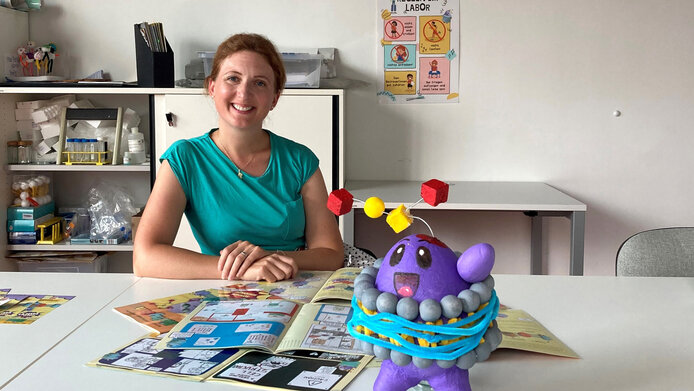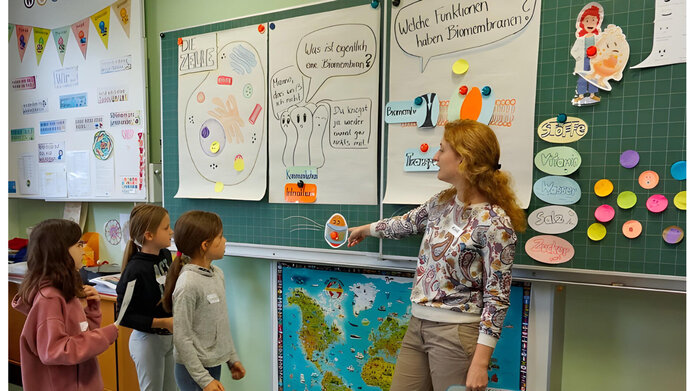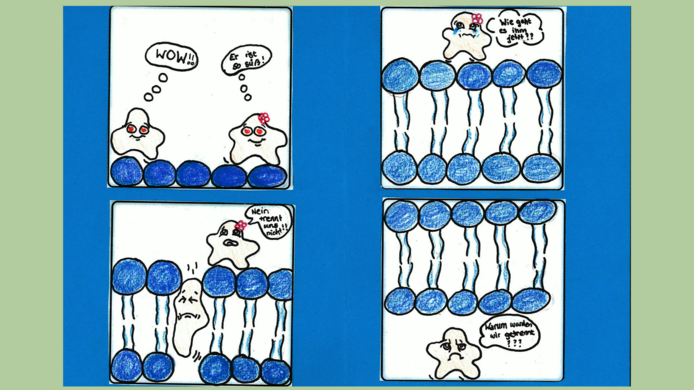Membrane proteins as comic characters

The cell, from the Latin “cellula,” which means “small chamber,” is the smallest living unit of all organisms. An adult is made up of around 100 trillion of these basic biological units. Each cell has a nucleus with DNA, which contains the instructions for producing all the proteins needed in the body to keep the cell's machinery running. The cell converts food, water, and air into the energy and building blocks the body needs. An important part of these metabolic processes takes place in the biomembranes, flexible layers that separate individual spaces within the cells as well as individual cells from each other.
In fact, all bodily functions are controlled directly or indirectly by the proteins contained in these membranes. They ensure communication between the cells and can both transmit external stimuli and react to them. For example, in the event of an injury, the pain signal is transmitted to the brain cells, triggering the immune response.
More information
Comics as a tool for science communication
In the FWF-funded project “BioPhyCom - Dive into the World of Biomembranes with Comics,” biochemist Ariane Pessentheiner is getting creative with science communication. In playful workshops, students aged 8 to 14 can explore the world of membrane biophysics through comic art. This is Pessentheiner’s second Science Communication project. It was launched in March 2023 with an official duration of two years. Since the start of the project, 16 workshops have been held with close to 300 participating kids. According to Pessentheiner, the project is meant to pique the students’ interest in the natural sciences and break down prejudices against research.
A disc-shaped research world
The idea for the project is based on the research work of Sandro Keller's laboratory group at the University of Graz, where Pessentheiner is currently working as a senior postdoc. Her work focuses on biomembranes and the best methods for studying them. The research potential behind membrane proteins is enormous, but these key proteins are insoluble in water, making it difficult to examine them using conventional, water-based analysis methods. One of the tools used in membrane biophysics are the so-called “nanodiscs.” Nanodiscs allow researchers to isolate and analyze membrane proteins in their natural environment, and are being further developed in the research group.
“A nanodisc looks like a maki sushi: the membrane protein in the middle, the lipid layer of the biomembrane like the rice all around, and like the maki seaweed layer, we have the polymer on the very outside that forms and holds nanodiscs together,” explains Ariane Pessentheiner. “Like with a cookie cutter, the membrane proteins can be removed from the biomembrane together with their lipid layer without damaging it.” Picture-based language makes it easier for the researcher to convey complex content and provides a good outlet for artistic expression.
Kids and teens as science communicators
The aim of the Science Communication project is to translate the newly learned content into science-based comics. Students have a variety of topics to choose from: love stories between proteins that are separated by a cell membrane, proteins cast as soccer players, or as characters in their favorite computer games. Pessentheiner makes sure that the comics remain scientifically accurate. At the same time, the young people find ways to connect complex scientific topics with their own lives, making their significance clear. Later, the illustrated stories will be scanned, printed as a comic book, and distributed to all participants as a souvenir of the workshop.
Keeping kids interested
According to Ariane Pessentheiner, the workshop design is flexible can be adapted to the needs of each individual class. “No two workshops are the same,” she emphasizes. “When you work with kids and teens, you need maximum flexibility.” For example, the researcher talks about the time she spontaneously came up with a new game to motivate a tired class. She called it “signal forwarding,” a fast form of a game like “telephone.” Players have to pass on a word as quickly as possible while following a special set of rules. The game illustrated the concept of cellular signal transduction and managed to get the kids excited and involved. Because it was so successful, Pessentheiner now uses the game in all her workshops.
Touchable research
“BioPhyCom - Dive into the World of Biomembranes with Comics” has been very well received. Schools have been contacting the science ambassador, who is listed with Austria’s Agency for Education and Internationalisation (OeAD), about her workshops for quite some time now. The workshops are offered either as one- or two-day events in schools or as a one-week workshop held during the “Summer Children's University” on the University of Graz campus. At the university, students are given guided tours of the lab and have the opportunity to meet researchers and ask them any questions they may have. This gives them insights into working in a lab and opens the door to a potential future career in this sector. Next February, Pessentheiner will be presenting the project at an Art & Science Day at the University of Graz, a public event she has organized.
Personal details
Ariane Pessentheiner studied biochemistry and molecular biomedicine at the University of Graz. Her dissertation and postdoc work focused on metabolic diseases, and she spent part of this time in San Diego, California. In 2021, she led her first FWF-funded Science Communication project at the Medical University of Graz, on the topic of cardiovascular diseases. She currently works as a project manager and science communicator at the University of Graz and as a freelance communications trainer. Her current project introducing students to membrane biophysics using comic workshops will run until the end of February 2025.







